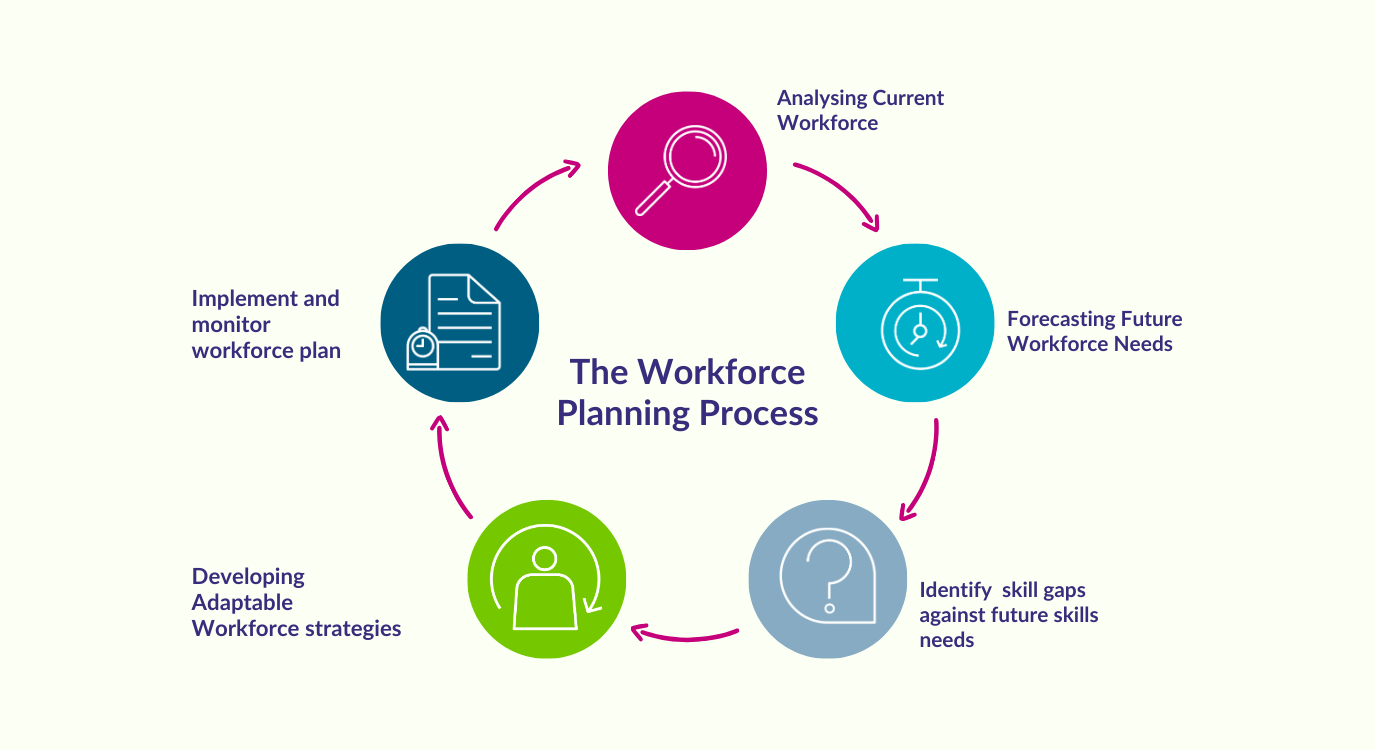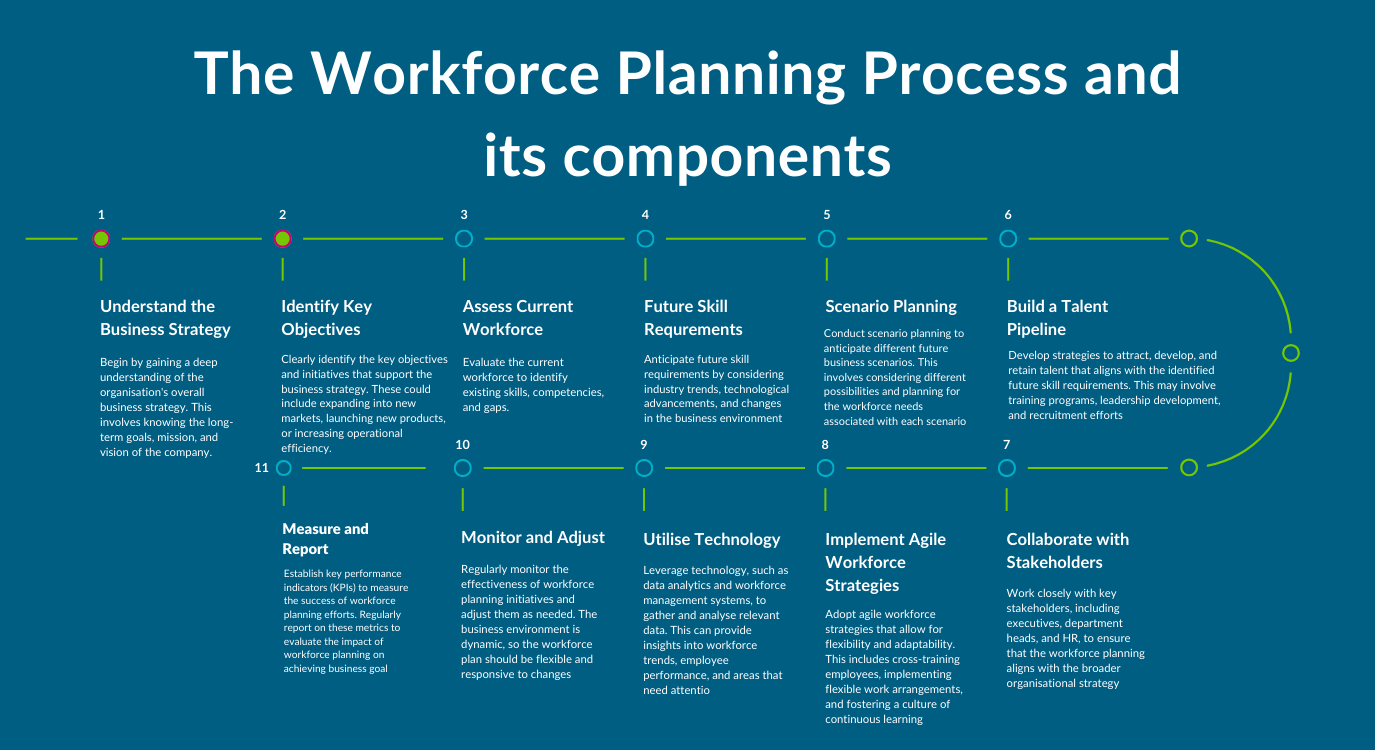
In the dynamic world of business, the strategic alignment of an organisation’s workforce with its business goals is crucial for success. This alignment is achieved through effective workforce planning, a process that ensures a company has the right people in the right roles at the right time.
Workforce planning is not just about filling vacancies; it’s about understanding the long-term goals of the business and strategically managing the workforce to meet these objectives. In this guide, we will explore the various facets of workforce planning, including strategic workforce planning, operational workforce planning, and their alignment with business strategy to achieve strategic objectives.
Key Takeaways
- Align with Business Goals: Ensure workforce planning is closely aligned with your business objectives, focusing on matching staffing needs with future company directions.
- Analyse and Forecast Needs: Regularly assess your current workforce and project future requirements, identifying skill gaps and areas for growth or reduction.
- Utilise Planning Tools: Employ workforce planning tools for accurate data analysis and trend forecasting, aiding in informed decision-making.
- Adapt and Stay Flexible: Maintain flexibility in your workforce strategy to adapt to market shifts, technological changes, and evolving business needs.
- Measure Effectiveness: Establish clear metrics to evaluate the success of your workforce planning, adjusting strategies as needed to meet your business goals.
Understanding Workforce Planning
The workforce planning process is a systematic, fully integrated organisational process that involves proactively planning ahead to avoid talent surpluses or shortages. It is based on the premise that a company can be staffed more efficiently if it forecasts its talent needs as well as the actual supply of talent that is or will be available.
When executed effectively, workforce planning minimises the risks associated with executing business strategy due to talent shortages or mismatches.
The Workforce Planning Process
The workforce planning process can take various forms but should avoid unnecessary complexity. It’s crucial to involve stakeholders from all parts of the organisation to ensure they grasp the data’s implications for both short- and long-term resourcing needs.
The workforce planning process typically involves these key steps:
- Analysing Current Workforce: This involves understanding your critical roles, the existing workforce’s composition, skills, experiences, and potential future contributions.
It is key to understand the organisation and its environment:
- What does the organisation’s structure look like now, and what’s likely in the future?
- What are the plans to increase productivity, including changes to the organisational structure and processes?
- Are there plans to introduce or update technology?
- Forecasting Future Workforce Needs: This step requires an understanding of the future direction of the business and the type of workforce required to support this direction.
- Analyse the workforce: Identify and analyse knowledge, skills, abilities, and talent profiles, as well as attrition rates and other factors such as employees’ views on job security, satisfaction, and intention to leave
- Gap Analysis: This involves identifying the gaps between the current workforce and future needs in terms of numbers, skills, and locations.
- Developing Adaptable Workforce Strategies: This includes strategies for recruitment, development, retention, and, if necessary, downsizing. An agile workforce that can adapt to change will help create a change-ready organisation that can proactively restructure as needed.
- Implementing and Monitoring: The final step is implementing the workforce plan and continuously monitoring and adjusting it as necessary.
While it’s convenient to describe workforce planning as a series of steps, it’s equally important to recognise its iterative nature, which can be illustrated as a cycle.

Strategic Workforce Planning
Strategic workforce planning is a future-oriented process, focusing on aligning the workforce requirements directly to the organisation’s strategic and business plans. This type of planning is concerned with ensuring that the organisation has the right people with the right skills at the right time in the future. It’s a critical component for achieving long-term strategic objectives.
Workforce Demand
In workforce planning, utilising workforce planning tools is essential for determining future workforce needs. These tools help assess the number and skills of employees required to align with an organisation’s strategic goals. Influenced by both internal strategies and external factors like technological shifts, effective planning hinges on understanding market trends and anticipating changes, such as AI advancements.
Accurate use of these tools ensures the organisation is equipped with the right talent for growth and adaptability, key to maintaining a competitive edge in a dynamic business landscape.
Operational Workforce Planning
In contrast, operational workforce planning is more short-term and focuses on managing the current workforce. It deals with the immediate workforce needs and is more reactive in nature. Operational planning ensures that the organisation can meet its immediate operational objectives.
Aligning Workforce Planning with Business Strategy
The key to effective workforce planning is its alignment with the overall business strategy. This alignment ensures that the organisation’s workforce is capable of meeting future business challenges. It involves understanding the strategic objectives of the business and then designing a workforce plan that supports these objectives.
Understanding Workforce Supply
A critical aspect of workforce planning processes is understanding the workforce supply. This includes not only the current workforce but also the external labour market. Organisations need to be aware of the external factors that can affect the availability and quality of talent, such as demographic changes, education trends, and market competition.
Developing a Comprehensive Workforce Plan
A comprehensive workforce plan addresses both the current and future workforce needs of the organisation. It involves a series of strategic decisions about how to shape and develop the workforce to ensure that the organisation can achieve its goals. This plan should be flexible enough to adapt to changing business needs and market conditions.
The Importance of Flexibility in Workforce Planning
Flexibility is a key component of effective workforce planning. The ability to adapt to changing business needs, workforce trends, and economic conditions is crucial. This means being able to scale up or down quickly, shift workforce priorities, and continuously update workforce strategies to align with changing business objectives.
Integrating Workforce Planning with Other HR Functions
Effective workforce planning is not an isolated activity; it should be integrated with other HR functions such as talent management, employee development, and succession planning. This integration ensures a holistic approach to managing the workforce and aligning it with the organisation’s strategic goals.
Measuring the Success of Workforce Planning
To determine the effectiveness of workforce planning, it’s important to measure its impact. This can be done through various metrics such as employee productivity, the cost of hiring, turnover rates, and the alignment of workforce capabilities with business needs. Regularly reviewing these metrics helps in fine-tuning the workforce plan and making necessary adjustments.
The below model offers a detailed overview of the Workforce Planning Process and it’s components
Conclusion
Effective workforce planning is essential for any organisation looking to achieve its strategic objectives. It involves a careful balance of understanding the current workforce, planning workforce supply, forecasting future needs, and aligning these with the business strategy.
By effectively planning for both the short-term and long-term, organisations can ensure that they have the right talent in place to meet their strategic goals. As the business world continues to evolve, the importance of effective workforce planning will only grow, making it a critical skill for any successful organisation.










